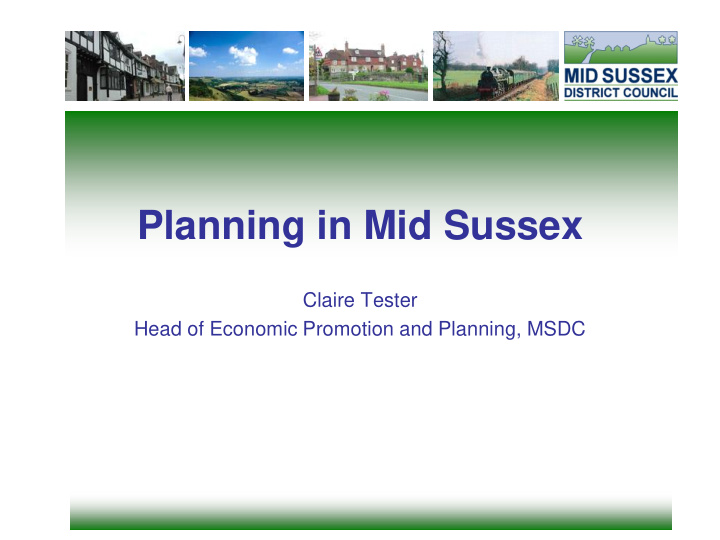



Planning in Mid Sussex Claire Tester Head of Economic Promotion and Planning, MSDC
Brief Update on District Plan • District Plan was submitted for examination in July • Exploratory Meeting in September and Hearing in November – both on the Duty to Co-operate • Inspector’s findings in December that MSDC had not met the Duty to Co-operate – not fully considered the potential to meet other area’s housing needs • MSDC had correspondence with PINs querying these findings. Now drawing to a close and likely to withdraw the Plan from examination • Meanwhile have been seeking advice on what further work is needed on: – Joint working with other councils and – Reviewing the evidence base and wording of the District Plan Report to Scrutiny Committee on 4 th June to agree timetable for • resubmission.
Process for Neighbourhood Plans • PC decision to prepare neighbourhood plan • MSDC designation of plan area • PC Preparation of plan, including informal consultation • PC formal public consultation on proposed plan (6 weeks) • PC minor revisions only • PC Submit plan and supporting documents to MSDC • MSDC conduct legal check to ensure all correct documents have been submitted and processes followed • MSDC publication for 6 weeks • Examiner appointed and sent plan, supporting documents and representations • Examiner may call a hearing, which the PC, MSDC and objectors participate in • Examiner reports, recommending whether plan should proceed to referendum and what area should be able to vote • MSDC considers whether to accept recommendations (if not must re-consult) • MSDC prepares Information Statement and calls referendum (28 days notice) • If referendum is positive MSDC ‘make’ the neighbourhood plan.
Basic Conditions A Neighbourhood Plan must meet the ‘basic conditions’ in that: • It has regard to national policy and guidance; • It contributes to sustainable development; • It is in ‘general conformity’ with the Mid Sussex Local Plan or District Plan • Is compatible with EU obligations.
National policy and guidance • National Planning Policy Framework sets out national policy. Neighbourhood Plan must comply with all of these unless it specifically only applies to local planning authorities. • National Planning Practice Guidance (published March 2014) is intended to explain how to apply the NPPF. • Particular refer to paragraph 17 of the NPPF – core planning principles – “every effort should be made objectively to identify and then meet the housing, business and other development needs of an area”.
Contribution to sustainable development • The purpose of the planning system is to contribute to the achievement of sustainable development, by performing: – An economic role, supporting growth; – A social role, providing housing and meeting community needs; and – An environmental role, protecting and enhancing the natural and built environment, improving biodiversity, prudent use of natural resources and adapting to climate change.
‘General conformity’ with the Local Plan • Neighbourhood Plans must be in general conformity with the Local/District Plan adopted at the time of NP’s submission. • Current plans such as Cuckfield and Hurstpierpoint have been prepared in context of the Mid Sussex Local Plan 2004. • But do need to ensure no conflicts with emerging District Plan otherwise the DP will ‘trump’ any NP policies once it is adopted.
EU Obligations Relevant obligations are: • EU Equalities and Diversity legislation; • Human Rights legislation • Strategic Environmental Assessment; • The Habitats Regulations – once the Plan policies have been finalised a screening statement needs to be requested from the District Council to confirm that the plan has no significant effect on the protected characteristics of Ashdown Forest. If it includes land within 7km of the Forest a full Appropriate Assessment will be needed.
NPPF – starting from needs • District Plan identifies a district-wide housing need of 10,600 homes 2011-2031 (530 per annum), of which 2,000 would be provided through neighbourhood plans. • The district-wide figure may change as a result of new information and duty to co-operate discussions. • Need to have a consistent approach to how housing need is worked out on a parish basis. Officers currently working up a methodology and will consult parishes on it shortly. • Should also look at needs of local businesses to expand. • Community needs, for instance for facilities, may drive location and scale of development to finance them. • New residential development will generate s106 and/or Community Infrastructure Levy, 25% of CIL direct to PC, 100% spent locally.
Next Steps for Horsted Keynes • Keep scope of plan to important local issues, don’t duplicate national or district level policies. • Important to involve a wide variety of people in the preparation of the plan – both to share the workload and to gain community support. • Good project management essential to steer the process and apportion tasks to different people and groups. • Seek help on the technical aspects – MSDC can provide support on Habitats, SEA and other legal requirements. • MSDC can also help with practical issues such as mapping. • May want to consider other professional support for content of the plan – such as DCLG support scheme. • Engage with your community and keep an audit trail of when this happened, who was consulted and about what, and how their comments influenced the plan. • Check content of plan and process with MSDC prior to formal public consultation as this should be your final plan.
Contacts • Councillor Norman Webster – Cabinet Member for Planning - 01342 317806 Norman.Webster@midsussex.gov.uk • Claire Tester – Head of Economic Promotion and Planning – 01444 477322 Claire.Tester@midsussex.gov.uk • Mark Bristow – Neighbourhood Planning Officer – 01444 477391 Mark.Bristow@midsussex.gov.uk
Recommend
More recommend